Rosie L. Latham & Neil A. Brown
Milner Centre for Evolution, Department of Life Sciences, University of Bath, UK
Visit Neil Brown — The University of Bath’s research portal
Toxigenic fungi contaminate our major cereal crops with a range of harmful mycotoxins, which threaten human and livestock health1. Despite monitoring systems used to prevent acute exposure, Aspergillus and Fusarium mycotoxins still threaten food and animal feed security2. Additionally, changing climates and their influence on mycotoxins pose an increasing risk to the safety of our food and feed cereal industry3,4.
Quick Facts!
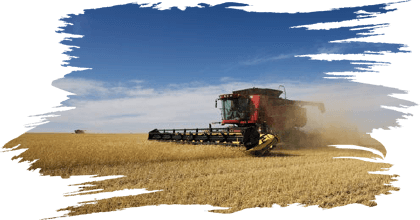
What are MYCOTOXINS and where do they come from?
Mycotoxins are toxic compounds naturally produced by fungi and pose a threat to human and animal health even at low concentrations1,6. There are approximately 300–400 known mycotoxins, with some of the most concerning being produced by Aspergillus and Fusarium species1. ⇰ These fungi produce mycotoxins such as aflatoxins, deoxynivalenol, fumonisins, T-2 and HT-2 toxins, and zearalenone7,8.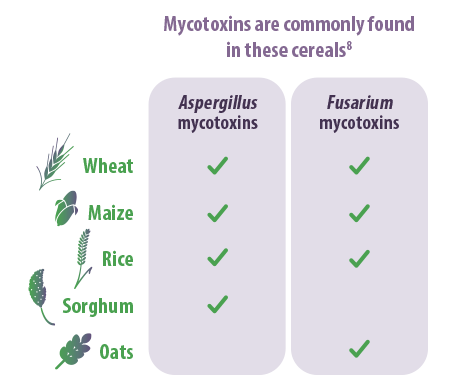
Aspergillus flavus and Aspergillus parasiticus are opportunistic pathogens of cereals both in the field and during crop storage. ⇰ Their most notorious products are aflatoxins (AF), which are classified as Class I human carcinogens9,10. Fusarium species are common in soils and infect crops in the field. ⇰ Fusarium head blight (FHB) is regarded as one of the most devastating fungal diseases in cereals and produces mycotoxins, such as deoxynivalenol (DON), nivalenol (NIV), T-2 and HT-2 toxins, zearalenone (ZEN) and fumonisins (FUM)8.
Health impacts Mycotoxin contamination is widespread, with a significant percentage of crops exceeding safety limits. This is of particular concern due to the human health impacts these mycotoxins can cause4.
FUSARIUM Fusarium species produce mycotoxins, such as DON and ZEN, that significantly reduce crop yields and pose health risks11-14. Deoxynivalenol (DON) disrupts protein synthesis, immune responses, and induces apoptosis15. DON is not static, as it transforms into DON-3-β-d-glucoside (DON-3G) within cereals. ASPERGILLUS The most notorious products associated with Aspergillus are aflatoxins, which are classified as Class I human carcinogens9,10. Aflatoxin B1 (AFB1) leads to weight loss, weakened immune responses, growth impairments, and even hepatocellular carcinoma or liver cancer18.
 Its adverse effects on mammalian health cause symptoms such as vomiting, reduced appetite, stunted growth, and developmental delays16.
Its adverse effects on mammalian health cause symptoms such as vomiting, reduced appetite, stunted growth, and developmental delays16. DON-3G appears less harmful, but gut bacteria can reverse this transformation, resurrecting the threat17. This ‘masked’ mycotoxin may secretly contribute to an increased total dietary mycotoxin burden.
DON-3G appears less harmful, but gut bacteria can reverse this transformation, resurrecting the threat17. This ‘masked’ mycotoxin may secretly contribute to an increased total dietary mycotoxin burden.
 Aflatoxins contribute to cancer but also cause digestive issues and reproductive problems.
Aflatoxins contribute to cancer but also cause digestive issues and reproductive problems. Mammals convert digested AFB1 into AFM1 that is excreted in their milk.
Mammals convert digested AFB1 into AFM1 that is excreted in their milk. The consumption of AFM1-contaminated milk also poses health risks, including stunted infant growth and increased susceptibility to infectious diseases19. Outbreaks can disrupt the entire milk supply chain4,20.
The consumption of AFM1-contaminated milk also poses health risks, including stunted infant growth and increased susceptibility to infectious diseases19. Outbreaks can disrupt the entire milk supply chain4,20.
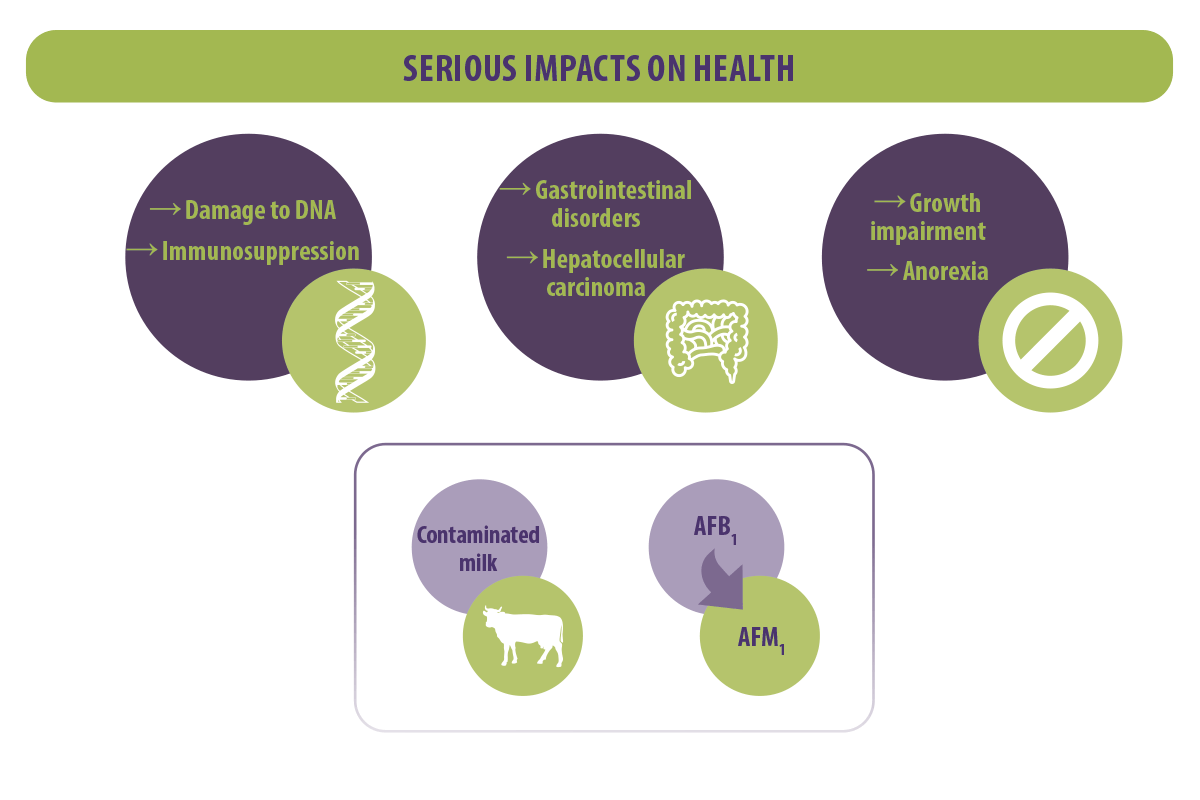
Economic impacts Both Aspergillus and Fusarium species can infect cereal crops in the field, inhibiting crop development, affecting grain production, and resulting in yield losses3,4,14,21,22,23.
Regulatory bodies, such as the EU Commission, establish legal thresholds to mitigate these risks24. However, this downgrading of contaminated cereals from food-to-feed reduces profit for the growers. Outright crop rejection also results in greater profit losses and causes additional costs associated with hazardous waste disposal25.
Aspergillus and Fusarium mycotoxins cost € billions
Recent findings bring to light the substantial economic impact of only two mycotoxins, aflatoxins and DON, on cereal farming. Between the years 2010 and 2019, approximately 75 million tonnes of wheat (5% of wheat for human consumption) exceeded the limit for DON. This resulted in a financial loss of €3 billion due to downgrading to animal feed3. Similarly, aflatoxins also caused downgrading of wheat destined to human consumption by 4.2% with an estimated additional €2.5 billion in losses4.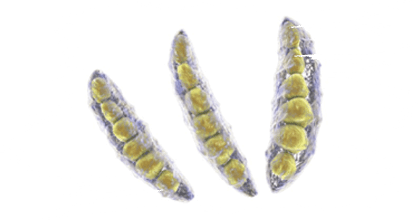
Figure 1. Contamination levels of food grains differ by grain for DON and aflatoxins. High levels of aflatoxin and DON contamination of food and feed cereals show that maize is of most concern4. Figure 2. Summary of the environmental influence on Aspergillus and Fusarium3,4. Climate Change and MYCOTOXINS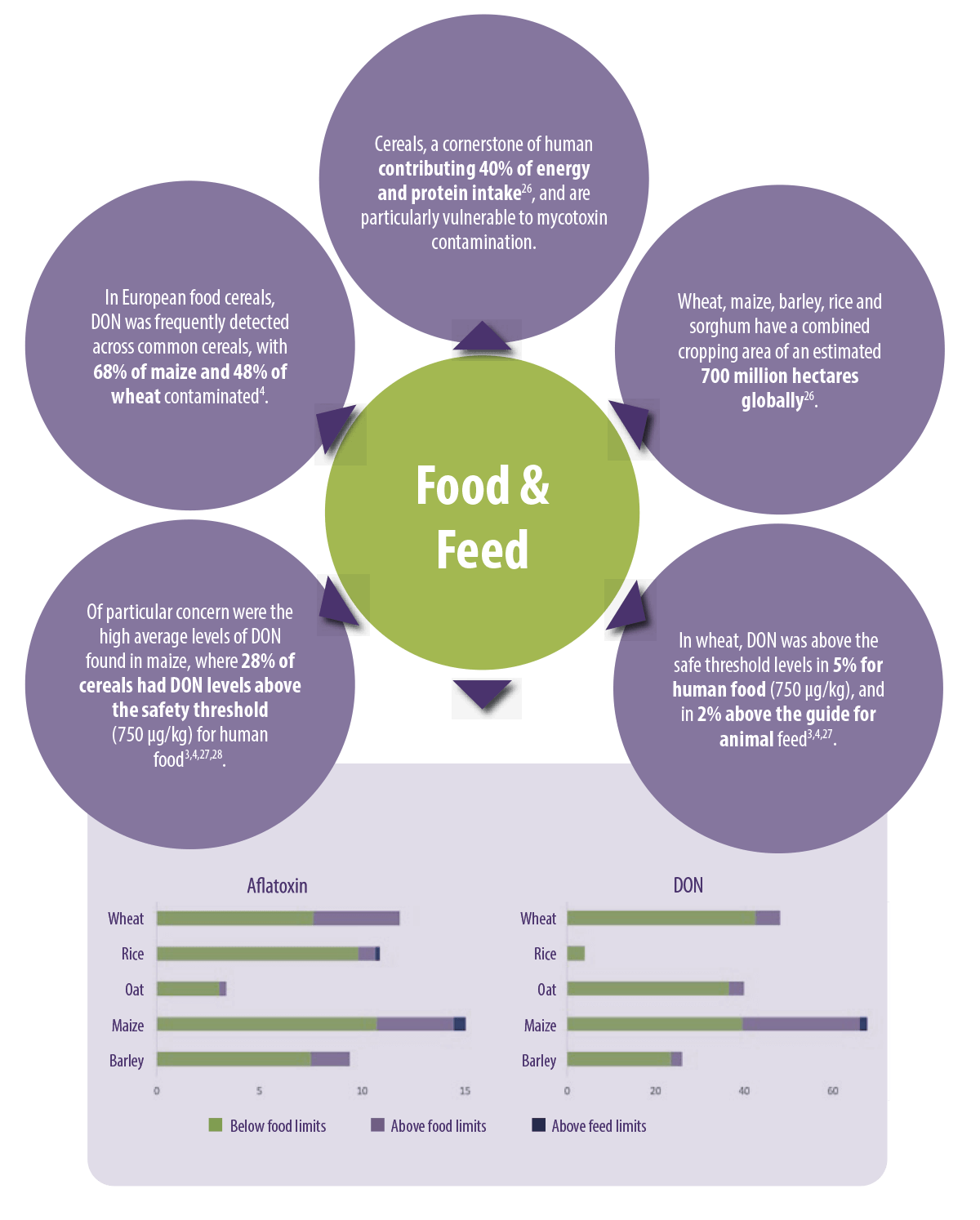
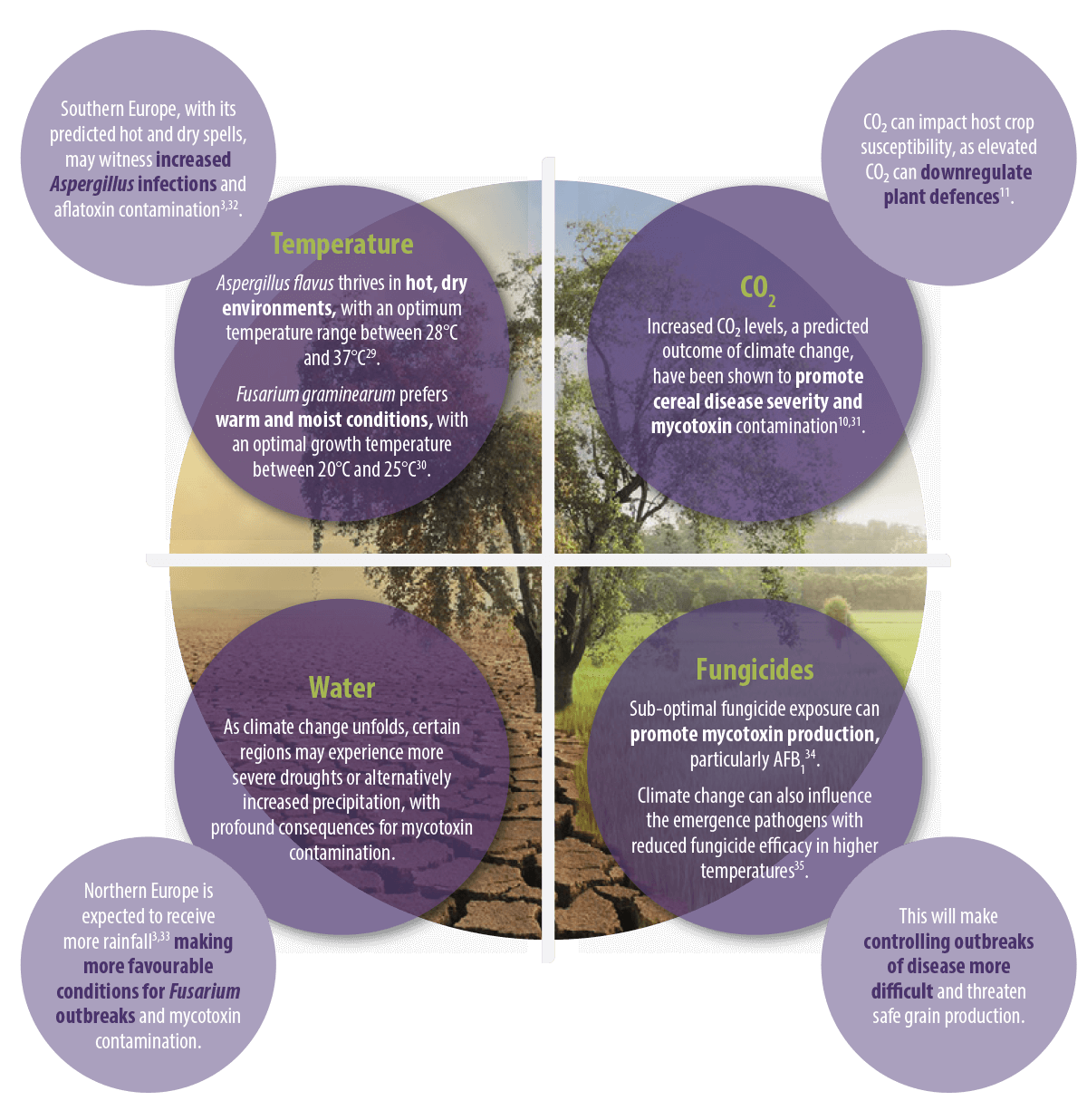

Aflatoxins are predicted to become a major food safety issue in maize, especially in countries where a rise in temperature, together with increased CO2 levels, and droughts are predicted to occur36. The optimum growth and mycotoxin production conditions show F. graminearum favoured by warm wet and A. flavus hot dry environments30. Climatic events, such as in northern Italy, have already been seen throughout the last decade in maize-growing regions prior to aflatoxin outbreaks37. Environmental changes threaten to increase the intensity and spread of mycotoxin contamination in Europe.
This issue requires efforts in the surveillance and control of mycotoxigenic fungal pathogens, to mitigate the risks they pose to sustainable safe cereal production.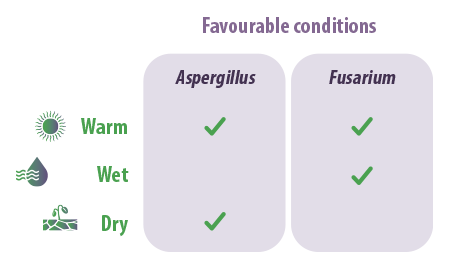
What are the future challenges?
Co-contamination raises pressing questions about the health implications of low level exposure to multiple mycotoxins. Johns (2022) found that in European wheat 25% of food and 45% of feed wheat containing DON tested positive for multiple FHB mycotoxins3.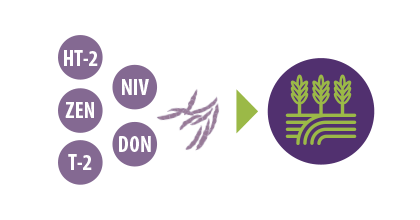
Mycotoxins can undergo partial detoxification within their host plants or animals, resulting in the formation of ‘masked mycotoxins’. Regional barriers that have prevented disease spread in the past (topography, distance, climate) are being removed. Climate change, altered agronomic practices, and increased global transportation, have made it possible for fungal pathogens to enter new regions.![]() These masked variants are challenging to detect and their presence in cereals introduces diverse economic and health impacts throughout our food and feed supply chains38.
These masked variants are challenging to detect and their presence in cereals introduces diverse economic and health impacts throughout our food and feed supply chains38.
Favourable conditions are expanding geographically. For example, some Fusarium species such as F. verticillioides, are expanding their range to higher latitudes in Europe due to warming climates and increased maize cultivation in those regions. This expansion adds to the complexity of FHB management, as regions previously unaffected may now face heightened risks3. Why is keeping an eye on these MYCOTOXIN threats challenging?
![]() Why test for pathogens that have never been recorded in an area before?
Why test for pathogens that have never been recorded in an area before?
![]() Traditional testing systems may not be effective in identifying masked mycotoxins or other Fusarium/Aspergillus mycotoxins. Using more sensitive and accurate detection techniques is imperative to assess the true extent of mycotoxin contamination38.
Traditional testing systems may not be effective in identifying masked mycotoxins or other Fusarium/Aspergillus mycotoxins. Using more sensitive and accurate detection techniques is imperative to assess the true extent of mycotoxin contamination38.![]() Changing agricultural practices influence the likelihood of outbreaks. For instance, increased use of minimum tillage farming, agricultural composting, and the cultivation of maize, can provide an accessible home for Aspergillus and Fusarium to sporulate and to overwinter, increasing disease pressure and the risk of mycotoxin contaminations39.
Changing agricultural practices influence the likelihood of outbreaks. For instance, increased use of minimum tillage farming, agricultural composting, and the cultivation of maize, can provide an accessible home for Aspergillus and Fusarium to sporulate and to overwinter, increasing disease pressure and the risk of mycotoxin contaminations39.![]() Infections can occur at various stages of crop growth, from seedling to post-harvest storage. What frequency of contamination is realistic and affordable to growers to maintain healthy safe crops?
Infections can occur at various stages of crop growth, from seedling to post-harvest storage. What frequency of contamination is realistic and affordable to growers to maintain healthy safe crops?![]() Mycotoxin monitoring systems do not provide knowledge of the changing pathogen populations, impeding our ability to understand what is driving outbreaks or increased threat levels.
Mycotoxin monitoring systems do not provide knowledge of the changing pathogen populations, impeding our ability to understand what is driving outbreaks or increased threat levels.![]() Global data on mycotoxigenic fungi and crop contamination is patchy. This hinders the improvement of holistic approaches to understand and mitigate their impact. The absence of data is not an absence of a mycotoxin threat.
Global data on mycotoxigenic fungi and crop contamination is patchy. This hinders the improvement of holistic approaches to understand and mitigate their impact. The absence of data is not an absence of a mycotoxin threat.

Conclusions
Toxigenic fungi, such as Aspergillus and Fusarium species, contaminate cereal crops with harmful mycotoxins, posing a threat to human and animal health. Mycotoxin contamination is widespread, with a significant percentage of crops exceeding safety limits. Despite efforts to prevent crop diseases, aflatoxins and deoxynivalenol still contaminate cereals, affecting food and animal feed security. More research into improved testing is required to understand the risk from masked mycotoxins and co-contaminants. Changing environments can increase the risk of cereal infection and mycotoxin contamination. Leading to increased economic costs and health issues. Co-ordinated research, industry, and governance efforts are needed to forecast and mitigate the growing mycotoxin threats.

REFERENCES 1. Bennett, J.W. and Klich, M. (2003) Mycotoxins. Clin. Microbiol. Rev. 16, 497, https://doi.org/10.1128/CMR.16.3.497-516.2003 2. Pitt, J.I. and Miller, J.D. (2017) A concise history of mycotoxin research. J. Agric. Food Chem. 65, 7021–7033, https://doi.org/10.1021/acs.jafc.6b04494 3. Johns, L.E., Bebber, D.P., Gurr, S.J. and Brown, N.A. (2022) Emerging health threat and cost of Fusarium mycotoxins in European wheat. Nat. Food 3, 1014, https://doi.org/10.1038/s43016-022-00655-z 4. Latham R.L., Boyle J.T., Barbano A., Loveman W.G., Brown N.A. (2023) Diverse mycotoxin threats to safe food and feed cereals. Essays in Biochemistry. 67, 797-809. 5. Alshannaq, A. and Yu, J.H. (2017) Occurrence, toxicity, and analysis of major mycotoxins in food. Int. J. Environ. Res. Public Health 14, 20, https://doi.org/10.3390/ijerph14060632 6. Navale, V., Vamkudoth, K.R., Ajmera, S. and Dhuri, V. (2021) Aspergillus derived mycotoxins in food and the environment: prevalence, detection, and toxicity. Toxicol. Rep. 8, 1008–1030, https://doi.org/10.1016/j.toxrep.2021.04.013 7. Eskola, M., Altieri, A. and Galobart, J. (2018) Overview of the activities of the European Food Safety Authority on mycotoxins in food and feed. World Mycotoxin J. 11, 277–289, https://doi.org/10.3920/WMJ2017.2270 8. World Health Organization. Mycotoxins. WHO. https://www.who.int/news-room/fact-sheets/detail/mycotoxins. 2018; Accessed September 20, 2023. 9. Jallow, A., Xie, H.L., Tang, X.Q., Qi, Z. and Li, P.W. (2021) Worldwide aflatoxin contamination of agricultural products and foods: from occurrence to control. Compr. Rev. Food Sci. Food Saf. 20, 2332–2381, https://doi.org/10.1111/1541-4337.12734 10. Food Standards Agency (2021) Mycotoxins, Food Standards Agency, London, https://www.food.gov.uk/business-guidance/mycotoxins 11. Vaughan, M., Backhouse, D. and Del Ponte, E.M. (2016) Climate change impacts on the ecology of Fusarium graminearum species complex and susceptibility of wheat to Fusarium head blight: a review. World Mycotoxin J. 9, 685–700, https://doi.org/10.3920/WMJ2016.2053 12. Kant, P., Reinprecht, Y., Martin, C., Islam, R. and Pauls, K. (2019) Disease resistance. Comprehensive Biotechnology, pp. 789–805, Elsevier, Amsterdam, The Netherlands 13. Dean, R., Van Kan, J.A.L., Pretorius, Z.A., Hammond-Kosack, K.E., Di Pietro, A., Spanu, P.D. Rudd, J.J., Dickman, M., Kahmann, R., Ellis, J. and Foster, G.D., (2012) The top 10 fungal pathogens in molecular plant pathology. Mol. Plant Pathol. 13, 414–430, https://doi.org/10.1111/j.1364-3703.2011.00783.x 14. Desjardins, A.E. and Proctor, R.H. (2007) Molecular biology of Fusarium mycotoxins. Int. J. Food Microbiol. 119, 47–50, https://doi.org/10.1016/j.ijfoodmicro.2007.07.024 15. Diamond, M., Reape, T.J., Rocha, O., Doyle, S.M., Kacprzyk, J., Doohan, F.M. and McCabe, P.F. (2013) The Fusarium Mycotoxin deoxynivalenol can inhibit plant apoptosis-like programmed cell death. PloS ONE 8, 8, https://doi.org/10.1371/journal.pone.0069542 16. Pestka, J.J. (2010) Deoxynivalenol: mechanisms of action, human exposure, and toxicological relevance. Arch. Toxicol. 84, 663–679, https://doi.org/10.1007/s00204-010-0579-8 17. Alizadeh, A., Braber, S., Akbari, P., Kraneveld, A., Garssen, J. and Fink-Gremmels, J. (2016) Deoxynivalenol and its modified forms: are there major differences? Toxins 8, 16, https://doi.org/10.3390/toxins8110334 18. Dhanasekaran, D., Shanmugapriya, S., Thajuddin, N. and Panneerselvam, A. (2011) Aflatoxins and aflatoxicosis in human and animals. In Aflatoxins (Ramo ·nGerardo,G.-G.,ed.),pp.221–254,IntechOpen,Rijeka,https://doi.org/10.5772/22717 19. Peles, F., Sipos, P., Gyori, Z., Pfliegler, W.P., Giacometti, F., Serraino, A. Pagliuca, G., Gazzotti, T. and Pócsi, I. (2019) Adverse effects, transformation and channeling of aflatoxins into food raw materials in livestock. Front. Microbiol. 10, 26, https://doi.org/10.3389/fmicb.2019.02861 20. Popovic, R., Radovanov, B. and Dunn, J.W. (2017) Food scare crisis: the effect on Serbian dairy market. Int. Food Agribusiness Management Rev. 20, 113–127, https://doi.org/10.22434/IFAMR2015.0051 21. Probst, C., Bandyopadhyay, R. and Cotty, P.J. (2014) Diversity of aflatoxin-producing fungi and their impact on food safety in sub-Saharan Africa. Int. J. Food Microbiol. 174, 113–122, https://doi.org/10.1016/j.ijfoodmicro.2013.12.010 22. Ferrigo, D., Raiola, A. and Causin, R. (2016) Fusarium toxins in cereals: occurrence, legislation, factors promoting the appearance and their management. Molecules 21, 35, https://doi.org/10.3390/molecules21050627 23. Kumar, A., Pathak, H., Bhadauria, S. and Sudan, J. (2021) Aflatoxin contamination in food crops: causes, detection, and management: a review. Food Production Process. Nutr. 3, 9, https://doi.org/10.1186/s43014-021-00064-y 24. European Commission (2006) Commission Regulation (EC) 1881/2006. Legislation.gov, https://www.legislation.gov.uk/eur/2006/1881 25. Alassane-Kpembi, I., Schatzmayr, G., Taranu, I., Marin, D., Puel, O. and Oswald, I.P. (2017) Mycotoxins co-contamination: methodological aspects and biological relevance of combined toxicity studies. Crit. Rev. Food Sci. Nutr. 57, 3489–3507, https://doi.org/10.1080/10408398.2016.1140632 26. Dunwell, J.M. (2014) Transgenic cereals: current status and future prospects. J. Cereal Sci. 59, 419–434, https://doi.org/10.1016/j.jcs.2013.08.008 27. EUR-Lex (2006) Commission Regulation (EC) No 1881/2006, European Union. EUR-Lex, https://eurlex.europa.eu/LexUriServ/LexUriServ.do?uri=OJ:L:2006:364:0005:0024:EN:PDF 28. Agriculture and Horticulture Development Board Fusarium and Microdochium in Cereals , Agriculture and Horticulture Development Board, Warwickshire, https://ahdb.org.uk/knowledge-library/Fusarium-and-microdochium-in-cereals#h25 29. Pitt, J. and Hocking, A.D. (2006) Aspergillus and related teleomorphs. Food spoilage microorganisms. Fungi and Food Spoilage, pp. 451–487, Springer, Cambridge, UK 30. Moreno-Amores, J., Michel, S., Loschenberger, F. and Buerstmayr, H. (2020) Dissecting the contribution of environmental influences, plant phenology, and disease resistance to improving genomic predictions for Fusarium head blight resistance in wheat. Agronomy-Basel 10, 16, https://doi.org/10.3390/agronomy10122008 31. Vary, Z., Mullins, E., McElwain, J.C. and Doohan, F.M. (2015) The severity of wheat diseases increases when plants and pathogens are acclimatized to elevated carbon dioxide. Global Change Biol. 21, 2661–2669, https://doi.org/10.1111/gcb.12899 32. Magan, N., Medina, A. and Aldred, D. (2011) Possible climate-change effects on mycotoxin contamination of food crops pre- and postharvest. Plant Pathol. 60, 150–163, https://doi.org/10.1111/j.1365-3059.2010.02412.x 33. Masson-Delmotte, V., Zhai, P., Pirani, A., Connors, S., Pe an, C., Berger, S. Y. Caud, L. Chen, M. I. Goldfarb, and Pedro M. Scheel Monteiro. (2021) Contribution of working group I to the sixth assessment report of the intergovernmental panel on climate change. Climate Change 2021: The Physical Science Basis, Switzerland 34. Felix D’Mello, J.P., Macdonald, A.M., Postel, D., Dijksma, W.T., Dujardin, A. and Placinta, C.M., (1998) Pesticide use and mycotoxin production in Fusarium and Aspergillus phytopathogens. European Journal of Plant Pathology, 104, pp.741-751. 35. Juroszek, P., Laborde, M., Kleinhenz, B., Mellenthin, M., Racca, P. and Sierotzki, H., (2022). A review on the potential effects of temperature on fungicide effectiveness. Plant Pathology, 71, 775-784. 36. Moretti, A., Pascale, M. and Logrieco, A.F. (2019) Mycotoxin risks under a climate change scenario in Europe. Trends Food Sci. Technol. 84, 38–40, https://doi.org/10.1016/j.tifs.2018.03.008 37. Magan, N., Medina, A. and Aldred, D. (2011) Possible climate-change effects on mycotoxin contamination of food crops pre- and postharvest. Plant Pathol. 60, 150–163, https://doi.org/10.1111/j.1365-3059.2010.02412.x 38. Sayyari, A., Faeste, C.K., Hansen, U., Uhlig, S., Framstad, T., Schatzmayr, D. and Sivertsen, T. (2018) Effects and biotransformation of the mycotoxin deoxynivalenol in growing pigs fed with naturally contaminated pelleted grains with and without the addition of Coriobacteriaceum DSM 11798. Food Addit. Contam. 35, 1394–1409, https://doi.org/10.1080/19440049.2018.1461254 39. Edwards, S.G. and Jennings, P., (2018) Impact of agronomic factors on Fusarium mycotoxins in harvested wheat. Food Additives & Contaminants: Part A, 35(12), pp.2443-2454.
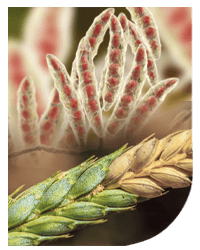



 Micotoxicosis prevention
Micotoxicosis prevention